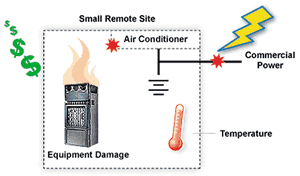Check out our White Paper Series!
A complete library of helpful advice and survival guides for every aspect of system monitoring and control.
1-800-693-0351
Have a specific question? Ask our team of expert engineers and get a specific answer!
Sign up for the next DPS Factory Training!

Whether you're new to our equipment or you've used it for years, DPS factory training is the best way to get more from your monitoring.
Reserve Your Seat Today
If you're not monitoring your small sites, you're gambling - you're making a bet that the damage caused by small-site failures will, on average, always be less than the cost of network monitoring.
But think about can go wrong at your small remote sites and what those problems can cost.
What do all these site failures have in common? They're all preventable, IF you have advanced warning of the problem. But failures like these happen all the time. And the damage they cause is a lot more expensive than the cost of an RTU. How many failures have you had, this year alone, at your small remote sites? How much are small site failures costing you?
Good point. Given what the suits like to call "today's budgetary realities," just because you need RTUs at your small sites doesn't mean you'll get the authorization to actually buy any.
But think hard about the assumptions that are keeping you from monitoring your small sites.Don't let a faulty cost-benefit analysis expose your network to preventable threats.
But are you really limited by these preconceived cost barriers? And if you're not, why shouldn't you monitor every site in your network?